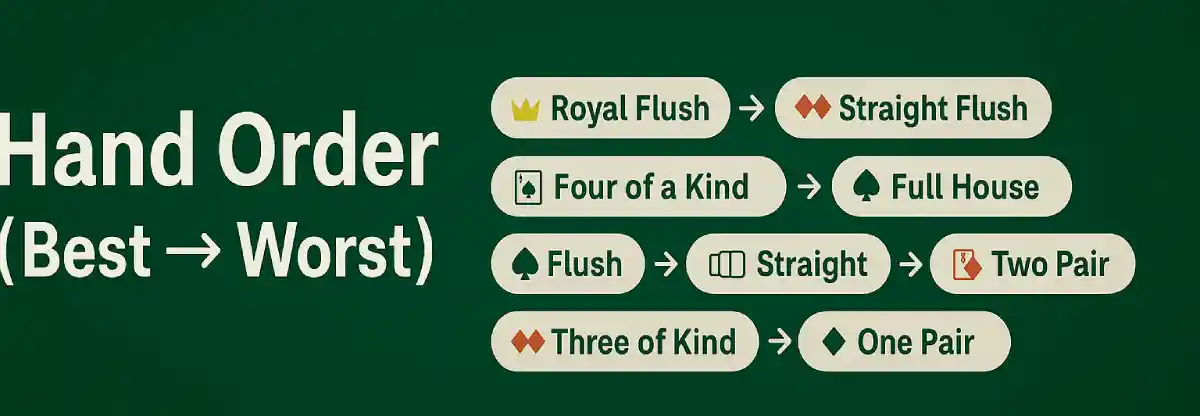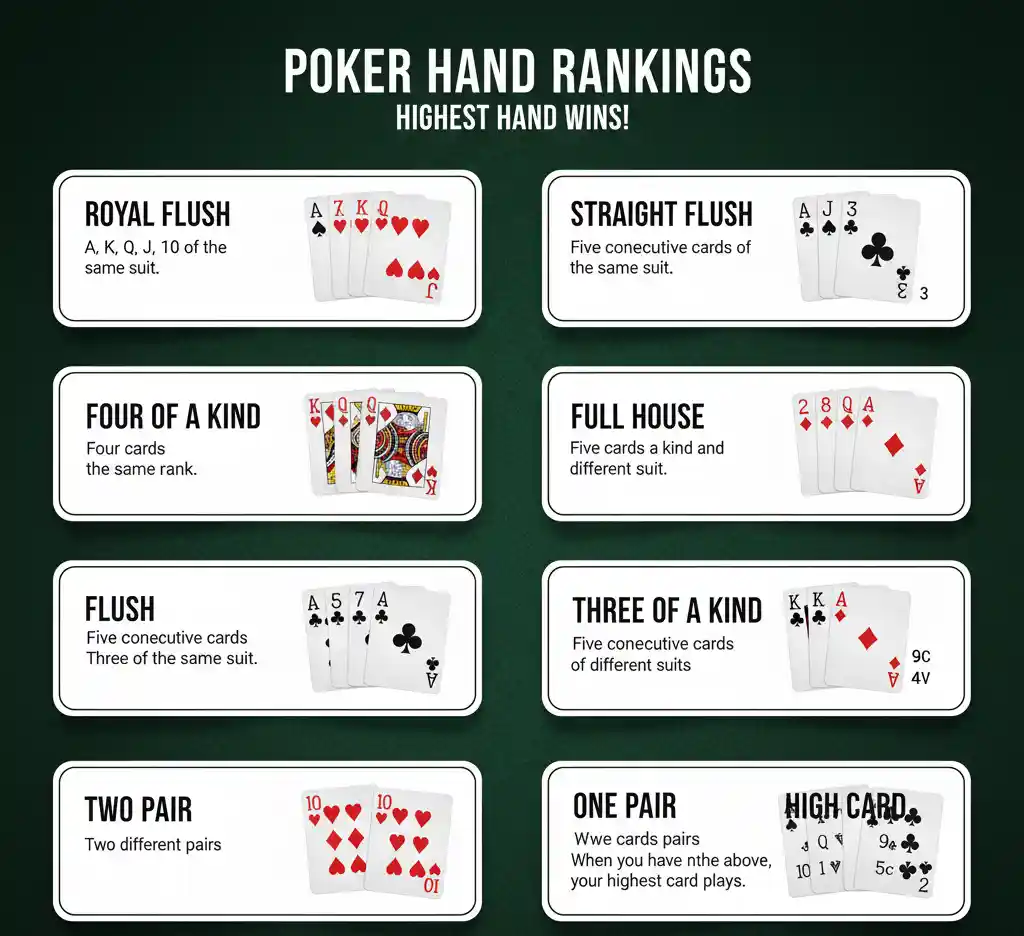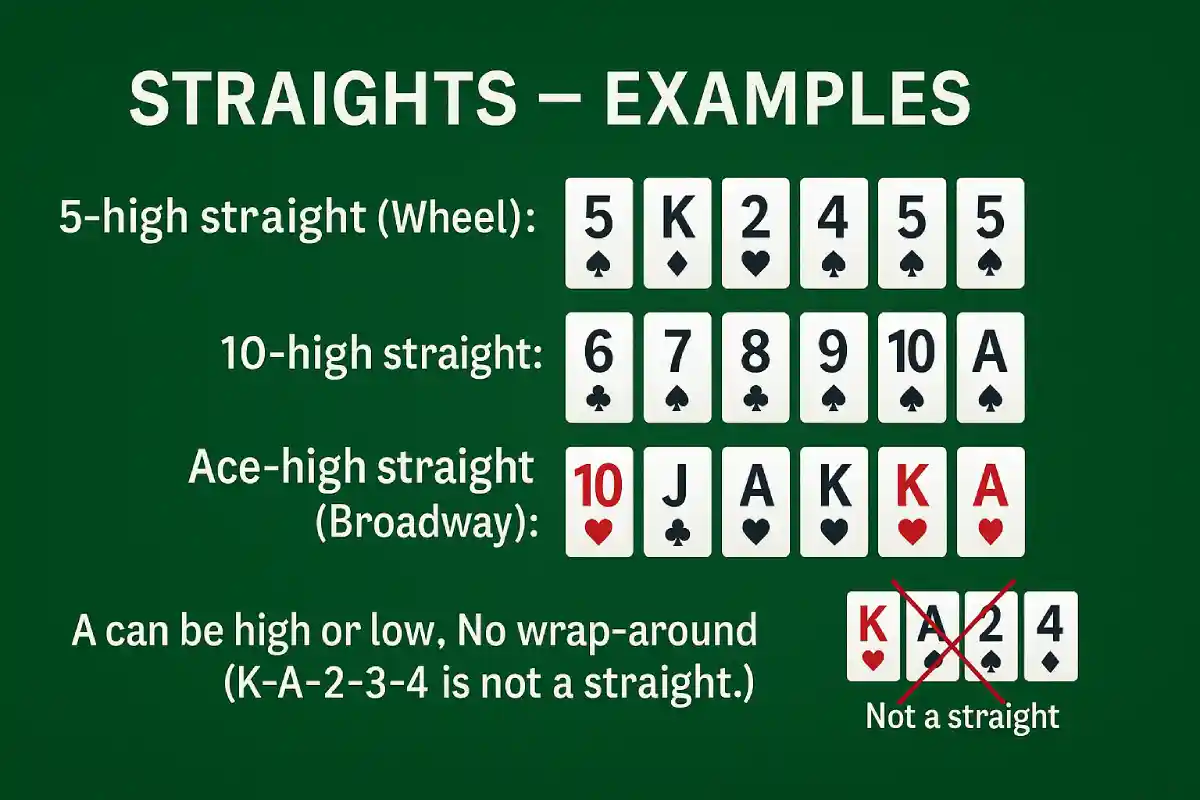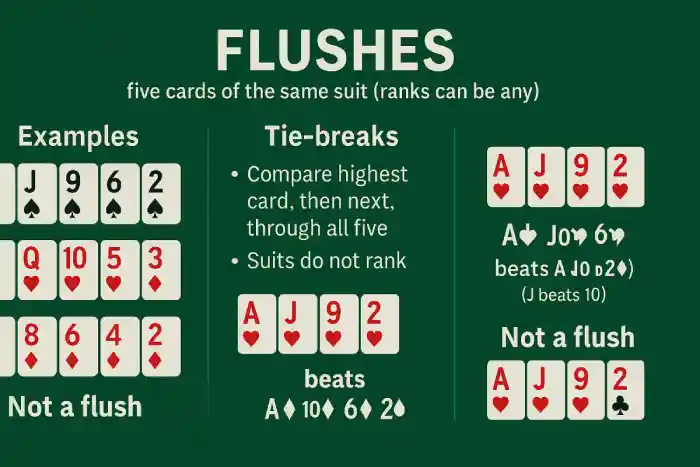-
Always look at the trips first.
8–8–8–A–A beats 7–7–7–K–K (because 8–8–8 > 7–7–7).
-
If the trips are the same (rare), compare the pair.
Q–Q–Q–J–J loses to Q–Q–Q–K–K (same trips, but K–K > J–J).
HAND RANKS: THE COMPLETE GUIDE (EASY)
Poker hands are always compared using five cards. In games like Texas Hold’em and Omaha, you may see seven cards total (your cards + the board), but your final hand is still the best five. Below is the hand order from best to worst, plus how to break ties.
♠ ♥ ♦ ♣
Suits do not have a rank in standard poker. Spades is not “better” than hearts, etc.
Hand Order (Best → Worst)

Poker hands are always compared using five cards. In Hold’em and Omaha you may see seven cards total (your cards + the board), but your final hand is still the best five. Below is the full order and how ties are broken.
-
Royal Flush
A-K-Q-J-10 of the same suit. This is simply the highest straight flush.
- If two players have a Royal Flush, the pot is split (suits don’t rank).
-
Straight Flush
Five in a row, same suit (e.g., 8♣-9♣-10♣-J♣-Q♣).
- Higher top card wins (Q-high beats 9-high).
- Aces can be high (10-J-Q-K-A) or low (A-2-3-4-5), not both.
-
Four of a Kind (Quads)
Four cards of the same rank + one side card (kicker).
- Compare the quads rank first; if equal, compare the kicker.
- Example: 9-9-9-9-A beats 9-9-9-9-K.
-
Full House
Three of a kind + one pair.
- Compare the trips first, then the pair.
- Example: Q-Q-Q-7-7 beats J-J-J-A-A (queens full beats jacks full).
-
Flush
Five cards of the same suit, any ranks.
- Compare the highest card, then next, through all five.
- Suits don’t break ties; only the five ranks matter.
-
Straight
Five in a row, any suits.
- Higher top card wins (10-high beats 9-high).
- Aces can be high (10-J-Q-K-A) or low (A-2-3-4-5, “the wheel”).
- No wrap-around (K-A-2-3-4 is not a straight).
-
Three of a Kind (Trips/Set)
Three cards of the same rank + two kickers.
- Compare the trips rank, then the highest kicker, then the next.
-
Two Pair
Two different pairs + one kicker.
- Compare the higher pair first, then the lower pair, then the kicker.
-
One Pair
One pair + three kickers.
- Compare the pair, then each kicker in order (1st, 2nd, 3rd).
-
High Card
No pair, no straight, no flush—just your five highest cards.
- Compare the highest card, then the next, through all five.
Using the board (Hold’em): if both players’ best five cards are the same five from the board, the pot is a split.
Poker Hand Rankings – Best to Worst (Infographic)

Straights

Flushes

Kickers: why they matter
A kicker is a side card that helps break ties when the main part of the hand is the same.
- One pair: compare the pair first, then the three kickers in order.
- Two pair: higher pair → lower pair → one kicker.
- Trips: trips rank → two kickers.
- Quads: quads rank → one kicker.
- High card: compare all five cards in order.
If all five cards match, the pot is split.
Example (one pair)
Player A
Q–Q–A–10–7
Player B
Q–Q–A–9–9
Compare: pair (Q–Q) same → top kicker A (same) → second kicker 10 vs 9 → Player A wins.
A kicker is a side card that helps break ties when the main part of the hand is the same.
- One pair: compare the pair first, then the three kickers in order.
- Two pair: higher pair → lower pair → one kicker.
- Trips: trips rank → two kickers.
- Quads: quads rank → one kicker.
- High card: compare all five cards in order.
If all five cards match, the pot is split.
Example (one pair)
Compare: pair (Q–Q) same → top kicker A (same) → second kicker 10 vs 9 → Player A wins.
Full House: how to compare
Using the board (Hold’em)
- In Texas Hold’em you make your hand from any 5 of the 7 cards (2 hole + 5 board).
- If the board already makes the best five (e.g., a straight or two pair) and both players use the same five, it’s a split pot.
- If both have a flush, compare the top five ranks in the flush to find the winner
(A–J–9–6–2 beats A–10–9–6–2).
Omaha note (important)
- You get 4 hole cards, but you must use exactly 2 of them + exactly 3 board cards.
- You cannot play the board by itself.
- For a flush, you must hold at least two cards of that suit in your hand.
- Example: board has four spades, but you hold only one spade → no flush in Omaha.
Short Deck / 6+ Hold’em
Some rooms use a shortened deck (cards 2–5 removed). Hand order can change—often
Flush beats Full House. Straights work a bit differently too (A can make
A–6–7–8–9). Always check local rules before you play.
Using the board (Hold’em)
- In Texas Hold’em you make your hand from any 5 of the 7 cards (2 hole + 5 board).
- If the board already makes the best five (e.g., a straight or two pair) and both players use the same five, it’s a split pot.
- If both have a flush, compare the top five ranks in the flush to find the winner (A–J–9–6–2 beats A–10–9–6–2).
Omaha note (important)
- You get 4 hole cards, but you must use exactly 2 of them + exactly 3 board cards.
- You cannot play the board by itself.
- For a flush, you must hold at least two cards of that suit in your hand.
- Example: board has four spades, but you hold only one spade → no flush in Omaha.
Short Deck / 6+ Hold’em
Some rooms use a shortened deck (cards 2–5 removed). Hand order can change—often Flush beats Full House. Straights work a bit differently too (A can make A–6–7–8–9). Always check local rules before you play.
Common mistakes to avoid
- Thinking suits rank (they don’t in standard poker).
- Calling a hand a “straight” when it wraps around K–A–2–3–4 (not allowed).
- Forgetting that kickers decide many pots with one pair and high-card hands.
- In Omaha, counting a flush with only one suited card in your hand (you need two).
- Misreading the board: sometimes the board already gives both players the same best five cards (automatic split).
-
Confusing “set” and “trips”:
- Set = you have a pocket pair and one of that rank hits the board (e.g., 7♦ 7♣ and the board shows one 7).
- Trips = the board pairs and you match it with one card (e.g., board has two 7s and you hold one 7).
Both are three of a kind; the naming is just table slang.
How to read a showdown (quick method)
- Straight Flush – higher top card wins.
- Four of a Kind – compare quads, then the kicker.
- Full House – compare trips, then the pair.
- Flush – compare the top five cards one by one.
- Straight – higher top card wins (A can be high or low).
- Three of a Kind – compare trips, then two kickers.
- Two Pair – higher pair → lower pair → one kicker.
- One Pair – pair first, then three kickers in order.
- High Card – compare all five cards, top down.
If the five best cards are exactly the same for both players, it’s a split pot.
Quick reference: how often hands happen (5-card odds, approx.)
- High Card~50%
- One Pair~42%
- Two Pair~4.8%
- Three of a Kind~2.1%
- Straight~0.39%
- Flush~0.20%
- Full House~0.14%
- Four of a Kind~0.024%
- Straight Flush (incl. Royal)~0.0015%
In Hold’em you see seven cards, so stronger hands appear more often — but the order above is always the same.
Terms you’ll hear
- Kicker
- Side card used to break ties when the main hand part matches.
- Broadway
- The 10–J–Q–K–A straight.
- The Wheel
- The A–2–3–4–5 straight (A is low).
- Trips / Set
- Both are three of a kind. “Set” = pocket pair + one on board. “Trips” = board pairs + you hold one.
- The Nuts
- The best possible hand at that moment.
- Chop / Split
- Pot shared between players with the same best five cards.
Fast checklist before you show
- Pick your best five cards.
- If straight or flush, confirm the top card order.
- For pairs/trips/two pair/quads, apply the kicker rules.
- If your five match your opponent’s five, it’s a split.
- In Omaha, confirm you used 2 from hand + 3 from board.